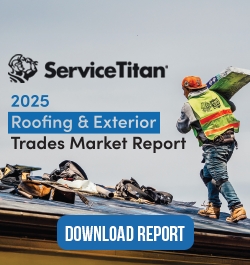7 tips for entering the roof maintenance sector
April 25, 2025 at 6:00 p.m.By John Kenney, Cotney Consulting Group.
Learn how to diversify your business and improve your revenue by offering commercial roof maintenance.
When you think about working in the roofing industry, many people imagine tearing down old, damaged roofs and replacing them with stunning, new systems. And while reroofing is a huge part of roofing, maintenance work is also incredibly important and can be a great revenue source for contractors. Specifically, diversifying your services to include the commercial roofing maintenance market can significantly grow your business. In an article for the Florida Roofing magazine by Florida Roofing and Sheet Metal Contractors Association (FRSA), John Kenney of Cotney Consulting Group shares a bit about the planning, marketing and training needed to break into this market and secure long-term success as a roofing business.
1 - Establishing credibility and professionalism
Before entering the commercial maintenance market, ensuring your business is positioned as a professional and reliable service provider is essential. The first impression matters, and many potential commercial clients will begin their search online. Having a well-designed website that highlights your commercial maintenance capabilities is critical. Dedicate a section of your website to showcase services, including detailed descriptions, case studies and client testimonials.
Case studies are particularly effective because they provide tangible evidence of your ability to deliver results. For instance, documenting how your team improved the lifespan and performance of a commercial roof through proactive maintenance can resonate with property managers seeking similar solutions. Investing in polished branding from your logo to uniforms, reinforces your professionalism and reliability.
2 - Leveraging existing networks
Your current network of clients and industry contacts is a valuable resource for entering the commercial sector. Many residential customers may have connections to commercial property managers or businesses requiring roof maintenance. Start by contacting your existing clients to inquire about referrals or introductions.
Additionally, join local business associations or professional networking groups to expand your commercial real estate community presence. Attending industry events and trade shows can also help you build relationships with decision-makers in the commercial property market. Over time, these connections can open doors to significant opportunities.
3 - Understanding commercial service pricing structures
Commercial roofing maintenance contracts often differ from residential and commercial jobs in scope, frequency and pricing. To succeed in this market, contractors must develop a comprehensive pricing model tailored to commercial clients. Factors to consider are the property size, frequency of maintenance visits and any specific client requirements, such as energy efficiency enhancements or specialized repairs.
Clear and accurate estimates are crucial. Property managers rely on contractors who can deliver detailed proposals that outline the full scope of services and associated costs. A professional proposal demonstrates your expertise and helps build trust with potential clients. Consider offering tiered maintenance packages such as basic, standard and premium plans to accommodate different budgets and needs.
4 - Targeting specific market segments
The commercial sector encompasses various properties, including office buildings, retail centers, warehouses and industrial facilities. Each segment has unique needs, so it’s important to identify which aligns best with your expertise and resources. For example, office buildings may prioritize appearance and energy efficiency, while industrial facilities might focus on durability and weather resistance.
Starting with smaller or less complex commercial properties can be an effective way to transition into this market. These projects allow contractors to gain experience and establish credibility before pursuing larger, more demanding clients. Additionally, targeting properties that align with your current capabilities ensures a smoother and more successful entry into the commercial sector.
5 - Investing in relationship building
In the commercial maintenance market, success often hinges on relationships. Building trust and rapport with property managers, facilities directors and business owners is key to securing long-term contracts. This requires consistent communication and exceptional customer service.
One relationship-building strategy is hosting informational seminars or networking events for commercial property managers. These events position your company as a knowledgeable and helpful resource while providing opportunities to connect with potential clients casually. Additionally, maintaining open lines of communication during and after projects helps reinforce your reliability and commitment to client satisfaction.
Providing regular updates and reports during maintenance contracts is another way to strengthen relationships. For instance, sharing detailed inspection findings, completed repairs and proactive recommendations demonstrates your expertise and dedication to protecting the client’s investment.
6 - Enhancing operational efficiency
Commercial clients value contractors who can deliver reliable and efficient services. To meet these expectations, roofing contractors must optimize their operations and ensure their teams are well-trained and equipped to handle the demands of commercial maintenance.
Investing in project management tools and scheduling software can streamline service delivery and improve team communication. These tools help track project progress, coordinate maintenance schedules and ensure timely responses to client inquiries. Adopting industry best practices and providing ongoing employee training ensures your team is prepared to handle the challenges of commercial projects.
Operational efficiency also involves maintaining a fleet of well-functioning vehicles and equipment. Ensuring your tools are in top condition minimizes downtime and enhances the quality of your work. Proactive maintenance for your equipment mirrors your services, reinforcing your commitment to reliability and professionalism.
7 - Developing a comprehensive marketing strategy
To effectively reach commercial property managers, you need a targeted marketing strategy. Start by identifying the pain points of your ideal clients, such as reducing repair costs, extending the lifespan of their roofing systems or improving energy efficiency. Use these insights to craft marketing materials that address their specific needs.
Digital marketing plays a crucial role in reaching commercial clients. In addition to digital channels, consider direct mail campaigns or in-person visits to introduce your services. A well-crafted brochure or informational packet can leave a lasting impression and prompt potential clients to reach out. Highlighting your experience, reliability and value-added services in these materials builds confidence in your abilities.
The path to long-term success
Breaking into the commercial roofing maintenance market requires a strategic approach but the rewards are worthwhile. By focusing on establishing credibility, leveraging networks, understanding pricing, targeting specific segments, building relationships, enhancing operations and developing a robust marketing strategy,
roofing contractors can position themselves for sustained growth and profitability.
As you take steps to enter this market, remember that persistence and adaptability are key. Building a reputation in the commercial sector takes time but with consistent effort and a commitment to excellence, your business can thrive in this competitive space. Start by evaluating your current capabilities, setting clear goals and implementing the strategies outlined in this article. Success is within reach for contractors willing to invest in the future of their business.
Original article source as seen in Florida Roofing magazine.: Florida Roofing and Sheet Metal Contractors Association
Learn more about Florida Roofing and Sheet Metal Contractors Association (FRSA) in their Coffee Shop Directory or visit www.floridaroof.com.























Comments
Leave a Reply
Have an account? Login to leave a comment!
Sign In